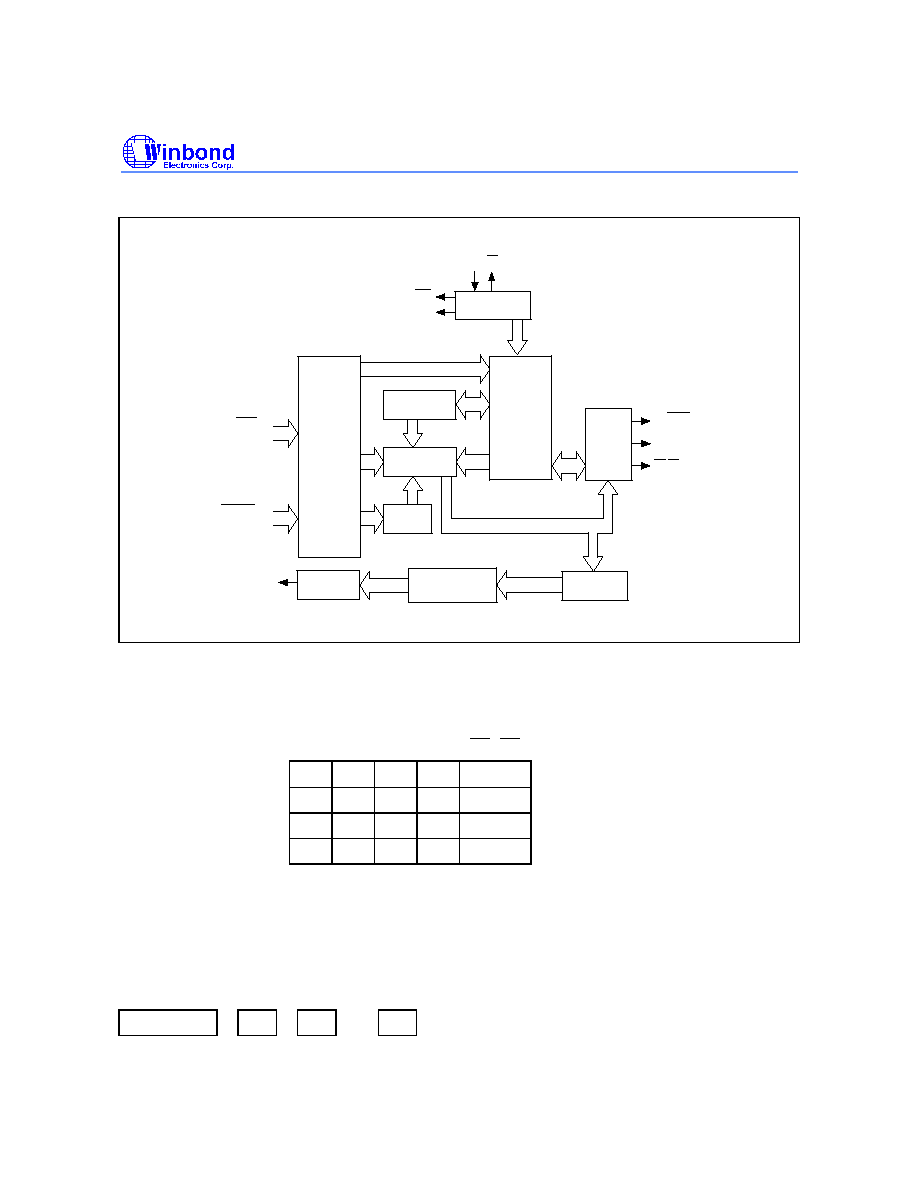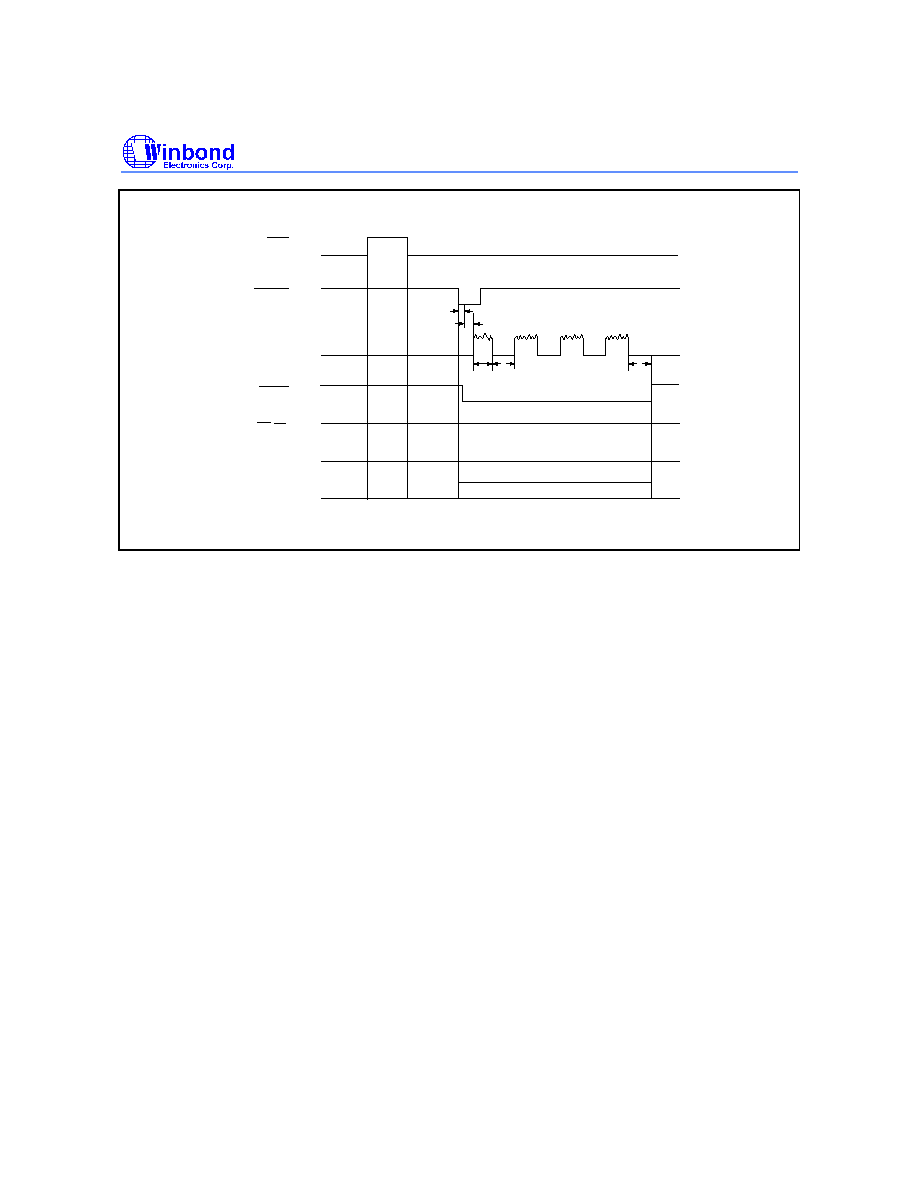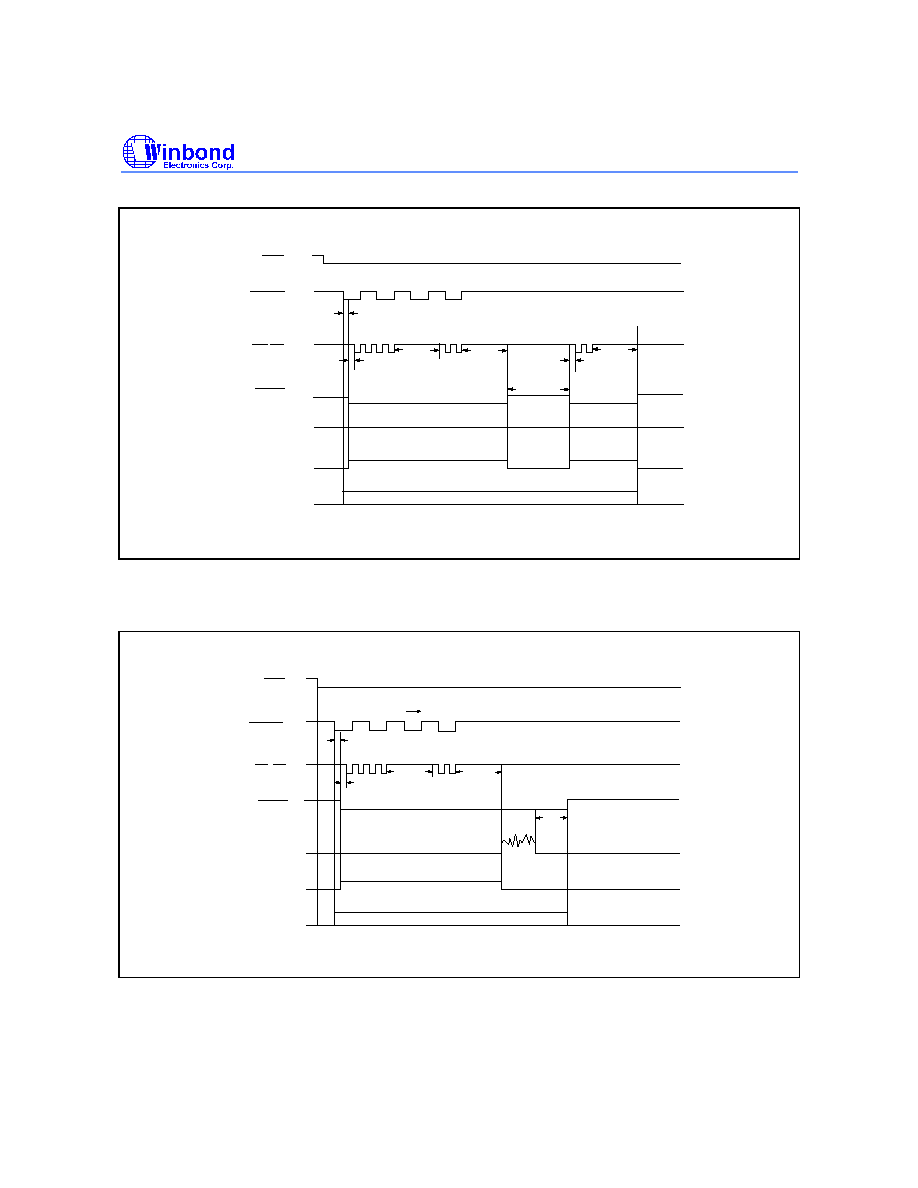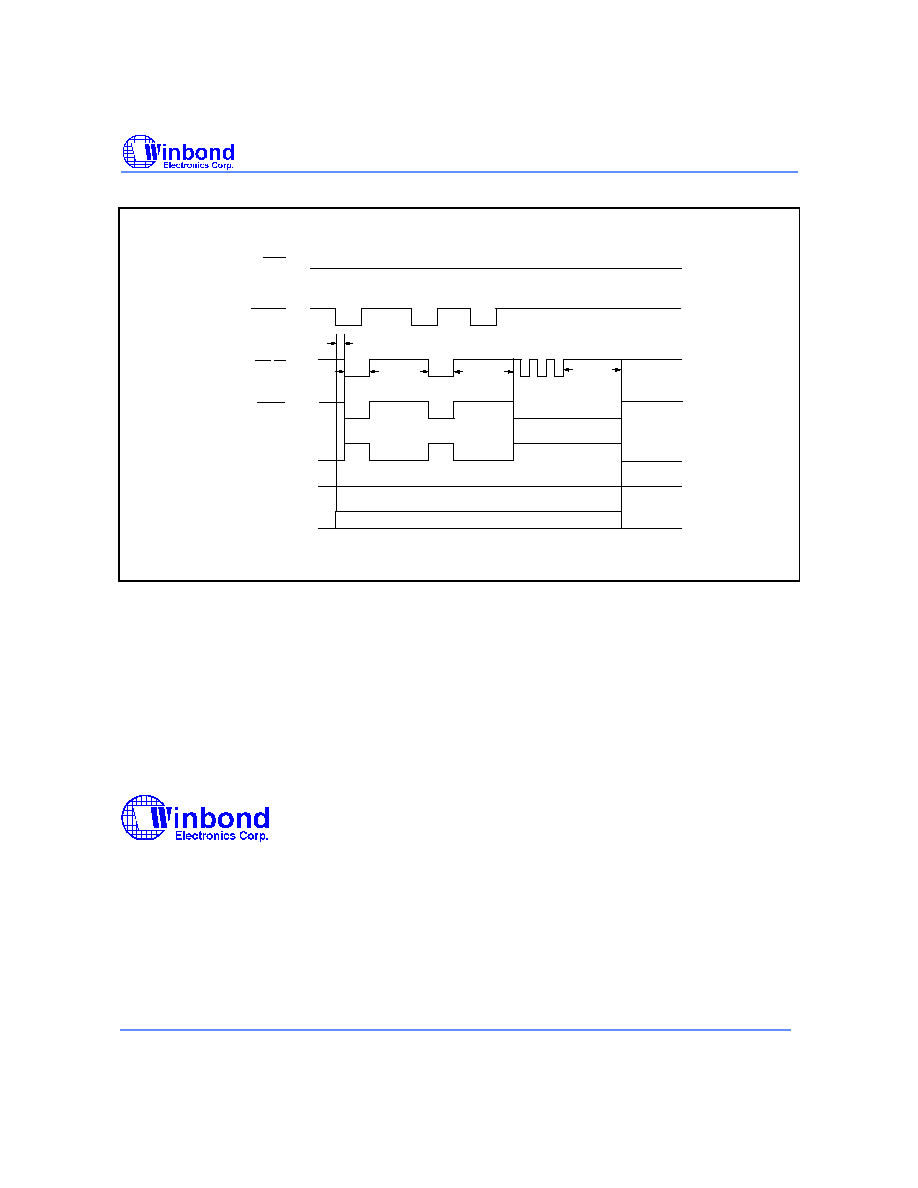 | –≠–ª–µ–∫—Ç—Ä–æ–Ω–Ω—ã–π –∫–æ–º–ø–æ–Ω–µ–Ω—Ç: W91610 | –°–∫–∞—á–∞—Ç—å:  PDF PDF  ZIP ZIP |

W91610 SERIES
TONE/PULSE DIALER WITH
TWO-STAGE REDIAL FUNCTION
Publication Release Date: July 1996
- 1 -
Revision A3
GENERAL DESCRIPTION
The W91610 series are Si-gate CMOS ICs that provide the signals needed for either pulse or tone
dialing.
FEATURES
∑
DTMF/Pulse switchable dialer
∑
32-digit redial memory
∑
Two-stage redial function
∑
Pulse-to-tone (P
T) keypad for long distance call operation
∑
Easy operation with redial, flash, pause and P
T keypads
∑
Pause, pulse-to-tone (P
T) can be stored as a digit in memory
∑
Tone output duration: as long as key is depressed or 90 mS minimum
∑
Minimum intertone pause: 90 mS
∑
Flash time: 100 mS
∑
Uses 4
◊
5 keyboard
∑
On-chip power-on reset
∑
Uses 3.579545 MHz crystal or ceramic resonator
∑
Packaged in 18-pin DIP
∑
The different dialers in the W91610 series are shown in the following table:
TYPE NO.
DIALING RATE
PAUSE
B:M
FLASH
W91610
10 ppS
4 sec
2:1
100 mS
W91611
3:2

W91610 SERIES
- 2 -
PIN CONFIGURATION
1
18
R4
C1
C2
C3
C4
V
2
3
4
5
6
13
14
15
16
17
R1
R2
R3
MODE
V
7
8
9
10
11
12
DTMF
DP/C5
HKS
XT
XT
T/P MUTE
P MUTE
DD
SS
PIN DESCRIPTION
SYMBOL
PIN NO.
I/O
FUNCTION
Column-
Row Inputs
1
-
4
&
15
-
18
I
Keyboard inputs are designed for use with either a standard 4
◊
5
keyboard or an inexpensive single contact (Form A) keyboard.
Electronic input from a
µ
C can also be used.
Valid key entry is defined by a connection between a single row
and a single column.
XT, XT
7, 8
I, O
A built-in inverter provides oscillation with an inexpensive
3.579545 MHz crystal or ceramic resonator.
T/P MUTE
9
O
The T/P MUTE is a conventional CMOS inverter output. It is low
during pulse and tone mode dialing sequence and flash break;
otherwise, it remains high.
MODE
13
I
Pulling the mode pin to V
SS
place the dialer in tone mode.
Pull to V
DD
or leave floating: Pulse mode (10 ppS, M/B = 2:3 or
1:2)

W91610 SERIES
Publication Release Date: July 1996
- 3 -
Revision A3
Pin Description, continued
SYMBOL
PIN NO.
I/O
FUNCTION
HKS
10
I
Hook switch input. Conventional CMOS input with an internal
protection diode and a pull-high resistor to V
DD
.
HKS = V
DD
: On-hook state. Chip in sleep mode, no operation.
HKS = V
SS
: Off-hook state. Chip enabled for normal operation.
During dialing, this input ignores HKS = V
DD
for durations of less
than 150 mS (i.e., dialing is not terminated).
DP /C5
11
O
Open drain dialing pulse output (Figure 1).
Flash key causes DP /C5 to be active in both tone mode and pulse
mode.
DTMF
12
O
During pulse dialing, maintains low state at all times.
In tone mode, outputs a dual or single tone.
Detailed timing diagram for tone mode is shown in Figure 2(a, b).
OUTPUT FREQUENCY
Specified
Actual
Error %
R2
R3
R4
C1
C2
C3
697
770
852
941
1209
1336
1477
699
766
848
948
1216
1332
1472
+0.28
-0.52
-0.47
+0.74
+0.57
-0.30
-0.34
R1
V
DD
, V
SS
14, 6
I
Power input pins.
P MUTE
5
O
The P MUTE is a conventional CMOS inverter output. It is high
during pulse dialing sequence and flash break. Otherwise, it
remains low.

W91610 SERIES
- 4 -
BLOCK DIAGRAM
HKS
MODE
T/P MUTE
COLUMN
ROW
XT XT
P MUTE
DP/C5
(R1 to R4)
DTMF
SYSTEM CLOCK
GENERATOR
READ/WRITE
COUNTER
RAM
LOCATION
LATCH
ROW & COLUMN
PROGRAMMABLE
COUNTER
DATA LATCH
& DECODER
KEYBOARD
INTERFACE
(C1 to C4)
D/A
CONVERTER
PULSE
CONTROL
LOGIC
CONTROL
LOGIC
FUNCTIONAL DESCRIPTION
Keyboard Operation
C1
C2
C3
C4
DP / C5
1
2
3
P
T
R1
4
5
6
F
P
R2
7
8
9
R3
*
0
#
R
R4
∑
F: Flash key
∑
P
T: In pulse mode, this key works as Pulse
Tone key
P
T key can be stored as a digit in pulse or tone mode
∑
R: Redial function key
∑
P: Pause key
Normal Dialing
OFF HOOK
,
D1
,
D2
, ...,
Dn
1. D1, D2, ..., Dn will be dialed out.

W91610 SERIES
Publication Release Date: July 1996
- 5 -
Revision A3
2. Dialing length is unlimited, but redial is inhibited if length oversteps 32 digits in normal dialing.
3. Dialing mode is determined at the on/off hook transition.
Redialing
1.
OFF HOOK
,
D1
,
D2
, ...,
Dn
, Busy,
Come
ON HOOK
,
OFF HOOK
,
R
The
R
key executes the redialing
function.
2. Redial content = D1, D2, ..., Dn
OFF HOOK
,
R
,
D1'
,
D2'
,
P
T
,
D3'
,
D4'
a. D1, D2, ..., Dn, D1', D2', P
T, D3', D4' will be dialed out.
b. Redial register is changed to D1, D2, ..., Dn, D1', D2', P
T, D3', D4'.
c.
OFF
HOOK
,
R
(1st)
D1, D2, ..., Dn, D1', D2', will be dialed
out,
R
(2nd); P
T, D3', D4' will be dialed
out.
Access Pause
OFF HOOK
,
D1
,
D2
,
P
,
D3
, ...,
Dn
1. The pause function can be stored in memory.
2. The pause function may be executed in normal dialing, redialing, or memory dialing (4.0
sec/pause).
3. The pause function can be stored as the first digit in memory.
4. The pause time depends on the number of times the P key is depressed. For example, if the
sequence 1, 2, P, P, 4, 5, 6 is keyed in, then the pause time is 8 seconds.
5. The pause function timing diagram is shown in Figure 3.
Pulse-to-tone (P
T)
1.
OFF HOOK
,
D1
,
D2
, ...,
Dn
,
P
T
,
D1'
,
D2'
, ...,
Dn'
a. If the mode switch is set to pulse mode, then the output signal will be as follows:
D1, D2, ..., Dn, no pause, D1', D2', ..., Dn'
(Pulse)
(Tone)
In this case, the device can be reset to pulse mode only by going on-hook, because tone mode
remains enabled after the digits have been dialed out.

W91610 SERIES
- 6 -
b. If the mode switch is set to tone mode, then the output signal will be as follows:
D1, D2, ..., Dn, no pause, D1', D2', ..., Dn'
(Tone)
(Tone)
c. The P
T key may be pressed before the first sequence is dialed out completely.
2.
OFF HOOK
,
R
a. If the mode switch is set to pulse mode, then the output signal will be as follows:
D1, D2, ..., Dn
(Pulse)
b. In the first redial operation, only the digits before the tone key are dialed out.
R
(2nd)
D1', D2', ..., Dn' are dialed out.
(Tone)
c. In the second redial operation, the digits after the tone key are dialed out.
Flash
OFF HOOK
,
D1
,
D2
,
D3
,
F
,
D4
,
D5
,
D6
1.
The
F
key may be pressed before digits D1, D2, D3 are sent completely. Digits D4, D5, D6 may
be pressed during the 100 mS. flash period.
2. The flash key cannot be stored as a digit in memory or in the redial register.
3. The content of the redial register is D1, D2, D3, D4, D5, D6.
The
F
key is not stored in the
redial
register.
4. The flash does not have first priority among the keyboard functions.
5. The flash pause time is 800 mS, so there is a pause of 800 mS between the flash and the next digit
dialed (see Figure 5).
6. The dialer will not return to the initial state after the flash break time has elapsed.
7. The flash function timing diagram is shown in Figure 5.
ABSOLUTE MAXIMUM RATINGS
PARAMETER
SYMBOL
RATING
UNIT
DC Supply Voltage
V
DD
-
V
SS
-0.3 to +7.0
V
V
IL
V
SS
-0.3
V
Input/Output Voltage
V
IH
V
DD
+0.3
V
V
OL
V
SS
-0.3
V
V
OH
V
DD
+0.3
V

W91610 SERIES
Publication Release Date: July 1996
- 7 -
Revision A3
Power Dissipation
P
D
120
mW
Operating Temperature
T
OPR
-20 to +70
∞
C
Storage Temperature
T
STG
-55 to +150
∞
C
Note: Exposure to conditions beyond those listed under Absolute Maximum Ratings may adversely affect the life and reliability of the
device.
DC CHARACTERISTICS
(F
OSC.
= 3.58 MHz, Ta = 25
∞
C, all outputs unloaded)
PARAMETER
SYM.
CONDITIONS
MIN.
TYP.
MAX.
UNIT
Operating Voltage
V
DD
-
2.0
-
5.5
V
Operating Current
I
OP
Tone, V
DD
= 2.5V
-
0.30
0.50
mA
Pulse, V
DD
= 2.5V
-
0.15
0.30
Standby Current
I
SB
HKS = 0, No load & No
key entry
-
-
15
µ
A
Memory Retention
Current
I
MR
HKS = 1, V
DD
= 1.0V
-
-
0.2
µ
A
DTMF Output Voltage
V
TO
Row group, R
L
= 5 K
130
150
170
mVrms
Pre-emphasis
Col/Row,
V
DD
= 2.0 to 5.5V
1
2
3
dB
DTMF Distortion
THD
R
L
= 5 K
V
DD
= 2.0 to 5.5V
-
-30
-23
dB
DTMF Output DC Level
V
TDC
R
L
= 5 K
V
DD
= 2.0 to 5.5V
1.0
-
3.0
V
DTMF Output Sink
Current
I
TL
V
TO
= 0.5V
V
DD
= 2.5V
0.2
-
-
mA
DP /C5 Output Sink
Current
I
PL
V
PO
= 0.5V
V
DD
= 2.5V
0.5
-
-
mA
P MUTE & T/P MUTE
Output Drive Current
I
MH
V
MO
= 2.0V
V
DD
= 2.5V
0.2
-
-
mA
P MUTE & T/P MUTE
Output Sink Current
I
ML
V
MO
= 0.5V, V
DD
=
2.5V
0.5
-
-
mA
Keypad Input Drive
Current
I
KD
V
I
= 0V, V
DD
= 2.5V
4
-
-
µ
A
Keypad Input Sink
Current
I
KS
V
I
= 2.5V, V
DD
= 2.5V
200
400
-
µ
A
Keypad Resistance
R
K
-
-
-
5.0
K
HKS Input Pull High
Resistance
R
HK
-
-
300
-
K

W91610 SERIES
- 8 -
Input Voltage Low Level
V
IL
Pins 1, 2, 3, 4, 10, 13,
0
-
0.2
V
DD
V
Input Voltage High Level
V
IH
15, 16, 17, 18
0.8
V
DD
-
V
DD
V
AC CHARACTERISTICS
PARAMETER
SYMBOL
CONDITIONS
MIN.
TYP.
MAX.
UNIT
Keypad Active in Debounce
T
KID
-
-
20
-
mS
Key Release Debounce
T
KRD
-
-
20
-
mS
Pre-digit Pause
T
PDP1
Mode Pin =
Floating
-
33.3
-
mS
10 ppS
Mode Pin = V
DD
-
40
-
Interdigit Pause (Auto Dialing)
T
IDP
10 ppS
-
800
-
mS
Make/Break Ratio
M/B
M/B = 1:2
-
33:67
-
%
M/B = 2:3
-
40:60
-
DTMF Output Duration
T
TD
Auto Dialing
-
90
-
mS
Intertone Pause
T
ITP
-
90
-
mS
Flash Break Time
T
FB
-
-
100
-
mS
Flash Pause
T
FP
-
-
800
-
mS
Pause Time
T
P
-
-
4.0
-
S
Pre-tone Mute
T
PTM
-
-
70
-
mS
Notes
:
1. Crystal parameters suggested for proper operation are R
S
<
100
, Lm = 96 mH, Cm = 0.02 pF, Cn = 5 pF, Cl = 18 pF,
F
OSC.
= 3.579545 MHz
±
0.02%.
2. Crystal oscillator accuracy directly affects these times.

W91610 SERIES
Publication Release Date: July 1996
- 9 -
Revision A3
TIMING WAVEFORMS
T
PDP
IDP
T
T
IDP
IDP
T
IDP
T
KID
T
3
2
R
PDP
T
B
M
T
T
T
PDP
PDP
T
T
KID
HKS
KEY IN
DP/C5
T/P MUTE
P MUTE
DTMF
OSC.
LOW
OSCILLATION
OSCILLATION
NORMAL DIALING
AUTO DIALING
Figure 1. Pulse Mode Timing Diagram
Timing Waveforms, continued
KID
TD
T
T
T
T
KRD
KRD
ITP
T
T
T
KRD
ITP
T
T
PTM
T
T
PTM
HKS
KEY IN
DTMF
T/P MUTE
DP/C5
P MUTE
OSC.
HIGH
LOW
OSCILLATION
OSCILLATION
KID
ITP
Figure 2(a). Tone Mode Normal Dialing Timing Diagram

W91610 SERIES
- 10 -
OSCILLATION
TD
T
T
T
ITP
ITP
T
KID
R
PTM
T
HKS
KEY IN
DTMF
T/P MUTE
DP/C5
P MUTE
OSC.
LOW
HIGH
Figure 2(b). Tone Mode Auto Dialing Timing Diagram

W91610 SERIES
Publication Release Date: July 1996
- 11 -
Revision A3
Timing Waveforms, continued
2
2
P
4
B M
M
B
KID
PDP
T
T
IDP
T
IDP
T
T
PDP
T
IDP
T
P
LOW
OSCILLATION
HKS
KEY IN
DP/C5
T/P MUTE
DTMF
P MUTE
OSC.
Figure 3. Pause Function Timing Diagram
T/P MUTE
8
2
4
M B
KID
PDP
T
T
IDP
T
IDP
ITP
T
T
P
T
HKS
KEY IN
DP/C5
DTMF
P MUTE
OSC.
OSCILLATION
B M
Figure 4. P
T Operation Timing Diagram in Normal Dialing

W91610 SERIES
- 12 -
Timing Waveforms, continued
F
KID
T
LOW
OSCILLATION
HKS
KEY IN
DP/C5
T/P MUTE
P MUTE
DTMF
OSC.
LOW
F
3
T
FP
T
FP
T
FB
T
IDP
Figure 5. Flash Operation Timing Diagram
Headquarters
No. 4, Creation Rd. III,
Science-Based Industrial Park,
Hsinchu, Taiwan
TEL: 886-3-5770066
FAX: 886-3-5792697
http://www.winbond.com.tw/
Voice & Fax-on-demand: 886-2-7197006
Taipei Office
11F, No. 115, Sec. 3, Min-Sheng East Rd.,
Taipei, Taiwan
TEL: 886-2-7190505
FAX: 886-2-7197502
Winbond Electronics (H.K.) Ltd.
Rm. 803, World Trade Square, Tower II,
123 Hoi Bun Rd., Kwun Tong,
Kowloon, Hong Kong
TEL: 852-27516023
FAX: 852-27552064
Winbond Electronics North America Corp.
Winbond Memory Lab.
Winbond Microelectronics Corp.
Winbond Systems Lab.
2730 Orchard Parkway, San Jose,
CA 95134, U.S.A.
TEL: 1-408-9436666
FAX: 1-408-9436668
Note: All data and specifications are subject to change without notice.











